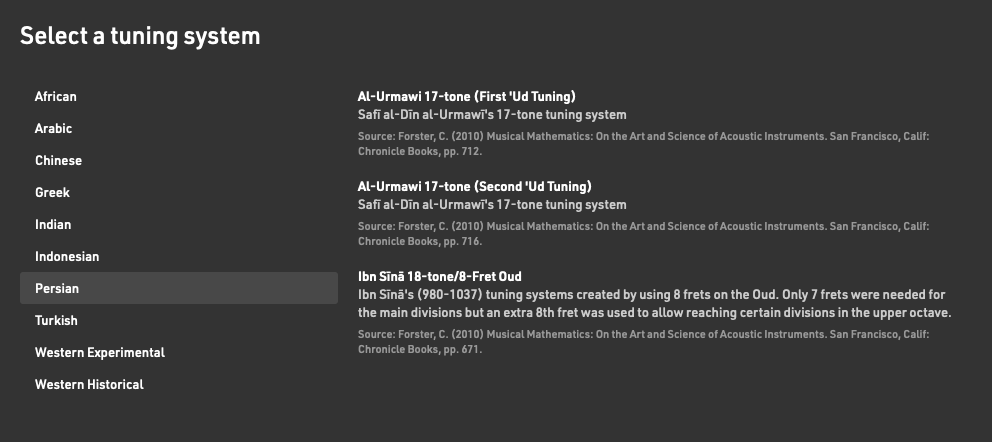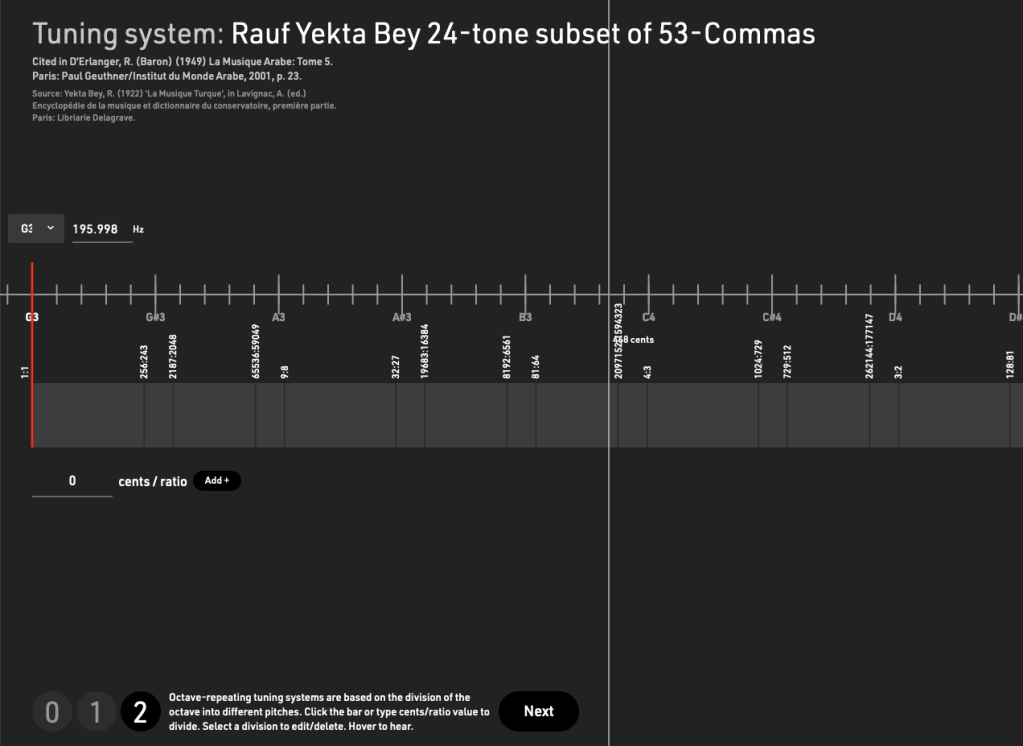Ableton has released another free Max for Live device. It’s cool, it can be useful, it’s free (if you have Live Suite or a Max for Live license). But it’s worth pausing to consider whether tuning solutions could be more.
First, here’s Ableton’s Microtuner. I think it does what it does very well – it’s free, it sticks to a consistent Ableton-style UI/UX, and it’s very competent at quickly loading Scala files and retaining compatibility with polyphony, polyphonic expression, and other tools with tuning support. It is at least good at representing equal subdivisions of an octave or ratios
https://www.ableton.com/en/packs/microtuner/
To download it, check under Packs (Live 11 + Max for Live required):

Maybe the only thing that is a bit strange about the demo is that the first impression may be of someone just intentionally detuning something at random. But even there, there’s nothing wrong or even particularly culturally significant about using “random” tuning – your ears are able to perceive nuances of intonation of all sorts, so there’s no reason not to be experimental with that. You can get amazing sounds out of detuned pianos and aging synths, for instance. Experimentalism itself is something that crosses all kinds of class and cultural boundaries in different ways around the world. So do go experiment!
The high point is probably fairly clever A/B panes (very Ableton) and blending (morphing), and it is a very clean, legible UI:

The design is a testament to Iftah Gabbai (formerly of skinnerbox), who’s a terrific musician, fun to hear and play with (the one time we got to jam), and a great developer and patcher. And it reflects the insights of Matt Jackson, who has a keen sense of how to manage products. The team did something they can be proud of.
But it’s still possible to criticize something like this and how it’s presented. (The old adage is something “worth criticizing.”) Why?
Well, before I amplify Khyam Allami’s objection, let me also stick my neck out there and say I object to how we’re talking about tuning, too. It clashes with my own understanding of the diversity of tuning practice even in so-called western concert music (which itself isn’t monolithic), let alone the larger world of musical activity.
Here’s the simple way to understand it: we really should be talking about tuning and intonation, not microtuning. That’s “tuning” as in how you set up an instrument, and “intonation” in how you play with tuning expressively. (If someone has better words, I’m all ears, but these are widely used.) And it can mean a lot of different things to different people and different cultures and different instruments and ways of playing.
“Microtuning” is potentially misleading, depending on how it’s used. Now, in New York, I knew folks playing in “microtonal” festivals which actually did suggest tuning without the restrictions of the 12-TET grid, in a culturally inclusive way. But there is a risk of suggesting that “microtonal” is “othered” relative to the pitch standard, or misrepresented as a subdivision of semitones – meaning it only can exist as further slicing up that grid.
There is even a general misconception that “microtuning” means “finding notes between twelve semitones.”
That may not be a fair complaint here, in that Microtuner relies on divisions of the octave, or ratios of divisions of the octave, rather than subdivisions of 12-TET. (As Paul Davis notes in comments, those aren’t the same thing.)
Either way, what Microtuner is absolutely missing is any context or cultural input. So it is still “microtonal” music as representing an objective approach to tuning, rather than something that that is itself dynamic and malleable by the player. That has its own cultural baggage as a result. The simple fact of the matter is, Live’s approach to tuning – even here where it’s meant to be more open and flexible – would seem foreign and restrictive to a great many of the world’s musical practitioners.
Now, on to Khyam Allami, whom Ableton have featured on their content side in the past – as have I. He has a deep background both as a musician and researcher, and has created some incredible tools and educational content around the topic of tuning, as well as diving into the political significance of the discussion in a thorough and critical way. It’s worth reading his whole thread if this topic interests you – and I’m also disappointed that the collaboration with him didn’t continue:
I think the important takeaway for musicians is, if you are interested in tuning, don’t limit yourself. Khyam recommends some other tools worth checking out:
But what does Khyam mean when he says he wants things to be meaningful and culturally inclusive? Well, take a look at his tool and how it provides context – because I think he’s got a point.
It’s one thing to read this on Twitter; I think even better is just to fire up Leimma (one of two tools he co-developed with Counterpoint). You can see this concept baked into the interface – there’s context, and there’s some cultural background. Culture isn’t just about “traditional” music and should absolutely not be something you try to think of through a national filter. But it is about discovering how other people play and how they think about what they play.
Just look – in Leimma, there’s some thoughtfulness to finding a tuning and where it came from:

And a better way to explore:

In fact, if you do use Ableton Microtuner, adding Leimma adds some context. It could be a great combo – or try one of the other tools above. Now instead of just working at random with Scala files, which frankly even for novices is likely to be really frustrating and unsatisfying, you can actually spend a few minutes training your ear and understanding the system.
You don’t have to become a musicologist here or dive into Persian classical music performance or something. But you’ll give your ears and perception a fighting chance of hearing what you’re doing.
So absolutely go use Microtuner if it appeals to you! Just consider adding some context with these other tools. And to developers, the music tech community – we can do better than this! This is criticism worth welcoming. But we also got this criticism before, and the frustration is that no one has really responded. Obviously, developers may or may not have the resources to pursue this in their products, but they could reach out and collaborate with people with other musical backgrounds. We do that all the time; why not do it here?
I am interested, for my part, to work with musicians who are trained in maqam practice, for instance. Here’s my friend Sami in his ongoing series which I mentioned before. (I’m gratified that now Berlin friends are following my NYC-era, grad school friend!) Obviously, we aren’t all going to do this, but it also makes little sense to exclude people practicing music this way with our technology. Rast doesn’t only have to be understood as a “traditional” tuning in some strict sense, either – you’ll find experimental musicians doing wild stuff with Rast, too, including with electronics.
I think hearing other musical tuning systems is a lot like experiencing another culture’s food. Even if you didn’t grow up with it, you can quickly find it feeling as though you’ve always known it. Just keep in mind, be a good guest – listen to the whole story behind that food and value the people who made it.
The music tech industry can’t just go around talking about expression. We have to actually make the technology expressive. And this is beautiful – so why shouldn’t synthesizers also learn this intonation language, since we can do it with our voices? (Sami absolutely will teach you that, if you have the time.)
More background on where Ableton’s tuning “grid” came from
Still with us? Then actually, let’s call out what those standardizations actually are, as they are snapshots from particular moments in time and even “western” is pretty imprecise. So when you use these on your Ableton Push or MIDI instrument, whether you’re aware of it or not, you’re using:
440 Hz reference pitch. Mid-20th century, with earlier examples back to the late 1800s. It’s still not universal in symphony orchestras, for instance, and there are many cases that use something slightly different. Largely advanced by the USA.
12-TET. Believe it or not, this has no one source – even if it is accurate to say its predominance now is an artifact of western colonialism. China has equal claim on it as the west. Equal divisions of the octave are not uncommon, as I said. I see Galileo’s dad was into it, even.
You want some third-century Chinese flutes approximating equal temperament? You got it. Confront this, baby! (Sorry, uh “A Third Century AD Chinese System of Di-Flute Temperament: Matching Ancient Pitch-Standards and Confronting Modal Practice.”)
https://www.jstor.org/stable/20753625
TL:DR – if you’re good at math and good at dividing strings (or possibly pipes), you’re likely to go this route at some point.
Church modes. This is more specific – think Roman Catholic church, early Middle Ages. (The eastern church uses something different, if not unrelated, and yet there’s no Hagiopolitan Octoechos mode on Ableton Push. That sounds like a joke, but hey, I grew up with the Octoechos! Seriously.)
The “modern” version comes from 1547, Glareanus, Dodecachordon.
Confused? Good! All tuning and intonation is culturally specific and there is no “objective” standard.
There are other presets in Live; I can try to break them down another time.
Comments? Glad to hear them.
Previously:
Bonus round:
Wendy Carlos, despite a reputation for things well-tempered, also works in developing tunings as part of her practice. Check out this article on asymmetric tunings. Actually, this alone could make an interesting patching/hack project, as there would be a few ways to represent and riff on this approach:
THREE ASYMMETRIC DIVISIONS OF THE OCTAVE
Speaking of context, one smart thing to do would be to read Wendy’s article, then approach the numerator/denominator section of the Generator in Microtuner.
But here’s the core of the question: are you following Wendy Carlos? Are you an oud player? Every idea has a cultural context. There’s no reason great design can’t be accessible and inclusive on training in tuning, just as it can make strides in accessibility for people with different vision (Ableton specifically has worked on color perception). There’s more to do here. That’s exciting – or will be, so long as we take it on.